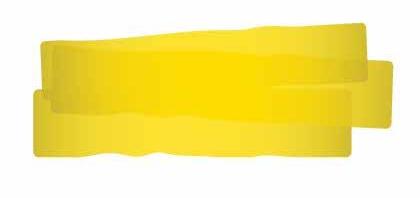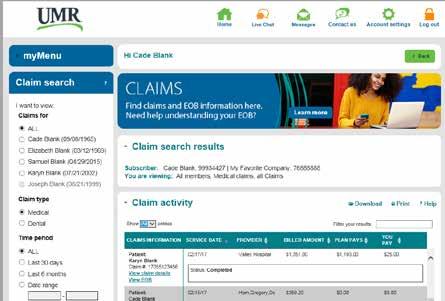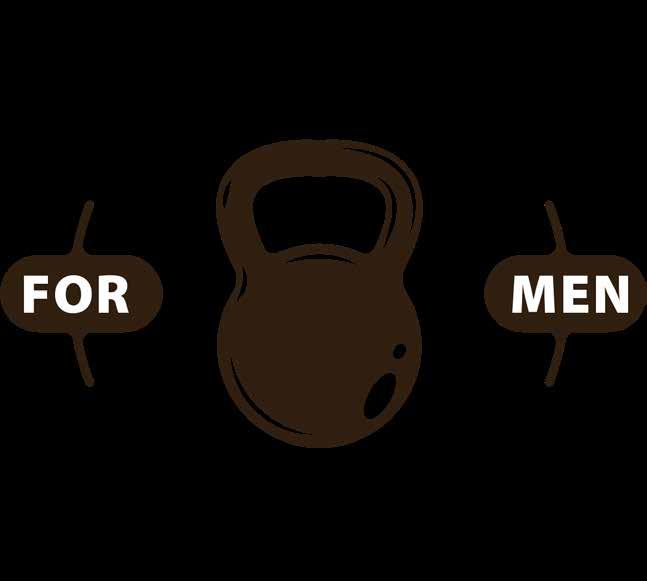Healthy You


Spring health hacks

‘Snack’ your way to a full workout
The power of positive self-talk


ORGAN DONATION





‘Snack’ your way to a full workout
The power of positive self-talk



“Healthy You” magazine is published as an educational resource for UMR members and provides information about tools and resources available from UMR as a part of our member online services.

Available features and benefits are dependent on the products and features included in the plan design. Not all members will have access to all features shown.
Copyright ©2023 United HealthCare Services, Inc.
Reproduction in whole or part is not permitted without permission in writing from UMR. All information and links were accurate and functional at the time of publication. However, because this electronic publication contains links to third-party sites, information can change and become unavailable.
While using this electronic publication, you may click on a link to other websites. We provide links to other websites that may contain information that may be useful or interesting to you. We do not endorse, and are not responsible for, the content and accuracy of linked websites operated by third parties or for any of your dealings with such third parties. You are solely responsible for your dealings with such third parties, and we encourage you to read the terms of use and privacy policies on such third-party websites.
12
This issue is packed full of “health hacks” to help optimize your wellness journey.

16
See
Learn how this diet aligns with what’s needed for a healthier, more sustainable lifestyle.
There’s more to wellness than not being sick. Learn more.
The UMR app has a smart, fresh look, simple navigation, and faster access to your health care benefits information. View your plan details on demand - anytime, anywhere. With a single tap, you can:

• Access your digital ID card

• Look up in-network health care providers
• Find out if there’s a co-pay for your upcoming appointment

• View your recent medical and dental claims
• Chat, call or message UMR’s member support team


Check in at your convenience to see if a claim has been processed and what you might owe. To get more details on a specific claim, click View claim details or View EOB. And, take advantage of the Action needed prompt to know when you need to follow up on a specific claim.

While good health takes lifelong effort, there are ways to make our path to wellness a little smoother. To help simplify your journey, we scanned the articles in this issue to find some “health hacks” – tips, techniques or shortcuts – to make managing your health a little easier. Hopefully, they’ll inspire you to expand your interest in healthy living.
(page 30)
You may be surprised to learn that wellness is about much more than just not being sick. Taking a few minutes to learn about the eight dimensions of wellness may change the way you think about your approach to health.
(page 20)
If you don’t have 30 minutes of time to exercise each day, there’s good news: Short snippets of activity count toward the recommended amount of exercise you should get each week. Think of small bites like climbing stairs, a short walk around the office or block, or doing jumping jacks while watching TV.
(page 22)
No one wants to spend their holiday in the emergency room. So, keep our six fireworks rules in mind as you head to your summer celebrations.
(page 23)
Practicing positive self-talk may improve self esteem, lower stress, and reduce symptoms of depression and anxiety. All it takes is “speaking” to yourself as compassionately as you speak to others.
(page 16)
By donating your organs and tissue after you die, you could save or improve as many as 75 lives. That’s a great reason to feel good about yourself while you’re living!
(page 26)
Consuming more plant-based meals has undisputed health advantages. Try “Meatless Mondays” to jumpstart healthier eating habits, then add in other components of a Mediterranean diet, which has been linked to numerous health benefits.





We all know the basics of a healthy you – rest, exercise and diet. A diet rich in vegetables, fruits, whole grains and healthy oils, while low in saturated fats from red meat, is essential for healthy nutrition. And while most men know this to be true, data from the International Food Council Foundation suggests that less than half the men in the U.S. actually follows a healthy diet.
Supplementing your diet with one daily multivitamin can help deliver the nutrition your body needs and make up for the deficiencies resulting from your diet.
Many nutritionists and doctors do not recommend a mega-dose vitamin. That’s a vitamin that contains more than 100% of the recommended daily allowance. But in general, a multivitamin will probably deliver the results needed.
Keep in mind that some medical conditions may require special supplements to your diet, so talk to your doctor about your specific nutrition needs before starting any new supplements or diets.
Older men’s bodies are usually deficient in certain vitamins compared to younger men's.


For example, men over the age of 70 usually need more vitamin D than middle-aged men. Again, talk to your doctor about your specific needs.
Your nutrition needs should be covered if you:
• Eat a well-balanced diet
• Take a standard multivitamin
• Take a vitamin D supplement of 1,000 international units (IU) every day
Helps absorb calcium and helps prevent weak muscles and bones. It becomes more important with age. Most men can benefit from taking 1,000 IU daily.
This vitamin B can help prevent heart disease because it prevents the build-up of homocysteine – a protein-building substance.
The daily recommendation is 400 micrograms.
Promotes a healthy nervous system. Older men may benefit because it boosts brain health.

Helps maintain good vision and a healthy immune system. You can probably get all you need from a healthy diet including fruits and vegetables.
Recommended daily intake is 3,000 IU.
This is a vital building block for good nutrition. It’s an antioxidant that protects the body by neutralizing free radicals that want to attack healthy cells.
The recommended daily dose is 90 milligrams.
Too little may increase the risk of colon cancer. One study found that men deficient in vitamin D are twice as likely to have a heart attack than men with normal levels.
Too much can cause muscle weakness and fatigue.

• Salmon
• Sardines
• Cod liver oil
• Milk
• Cheese
• Egg yolk
• Orange juice
Fortified breakfast cereal
• Leafy green vegetables
• Sweet potatoes
an upset stomach.
• Brussels sprouts
• Strawberries
• Tomatoes
• Melons
• Pineapple
• Asparagus
These vitamins are considered essential for men’s health in the right amounts.
It’s important that you talk to your doctor before taking any new supplements or changing the dosage of a supplement.
My sepsis story started with a urinary tract infection (UTI).
I got confused and weak, and I didn't realize I was so sick. My wife drove me to the ER right away.
This overwhelming and life-threatening response can lead to tissue damage, organ failure and death.
At least 1.7 MILLION ADULTS in America develop sepsis each year.*
My sepsis story started with a small cut on my knee. I was fine and then I wasn’t!
The infection spread, I was nauseated and getting hot then cold. My boyfriend recognized the signs and took me to the hospital.
An infection anywhere in the body may set off the response that leads to sepsis. Common places where an infection might start include:
Bloodstream
Bones
(common in children)
Bowel
Kidneys
SEPSIS or the infection causing sepsis STARTS BEFORE a patient goes to the hospital IN NEARLY 87% OF CASES .*
Lining of the brain
Liver or gallbladder
Lungs
Skin
A recent hospitalization: Common sites of infection include IV lines, surgical wounds, surgical drains and sites of skin breakdown, known as bedsores.
Adults 65 or older
Children younger than a year
People with weakened immune systems
People with recent severe illness
People with chronic medical conditions like diabetes, lung disease, cancer or kidney disease
People who have survived sepsis
Blood pressure drops, resulting in shock. Major organs and body systems, including the kidneys, liver, lungs and central nervous system, may stop working properly because of poor blood flow.
The earliest signs of sepsis may include a change in mental status or very fast breathing.
In general, symptoms of sepsis can include:
Chills, shivering or feeling very cold
Fever
Confusion, disorientation or delirium
Lightheadedness due to low blood pressure
High heart rate or weak pulse
Skin rash or mottled skin
Warm, clammy or sweaty skin
If you experience a combination of these symptoms, call 911 or go to the nearest hospital with a support person.
My sepsis story started with a bad tooth infection.
I had never heard of sepsis. Thankfully, my primary care doctor recognized the signs and helped me take action.
My sepsis story started when I had my appendix removed.
I got an infection at my IV site. My mom and dad asked if it could be sepsis. They were glad they did!
1 IN 3 PEOPLE who die in a hospital had sepsis during that hospitalization.*
EVERY MINUTE COUNTS. SAY, “I AM CONCERNED ABOUT SEPSIS.”
T
Body temperature may be higher or lower than normal
I
M
May have signs and symptoms of an infection
May be confused, sleepy or difficult to rouse
E
May have severe pain, discomfort or shortness of breath
A doctor will examine the patient and ask about their medical history. They likely will order a blood test. But blood tests may not find some sources of infection that can cause sepsis, or they may miss infections in people who have been receiving antibiotics.
Other tests may include:
Blood differential
Blood gasses
Kidney function tests
Platelet count, fibrin degradation products and coagulation times (PT and PTT) to check for bleeding risk
White blood cell count
A person with sepsis will be admitted to a hospital, usually in the intensive care unit (ICU). Antibiotics are usually given through a vein.
Other medical treatments include:
Oxygen to help with breathing
Fluids given through a vein
Medicines that raise blood pressure
Dialysis if there is kidney failure
A ventilator if there is lung failure
It’s important to ACT QUICKLY if a person has an infection that isn’t getting better or is getting worse. With early recognition and treatment, most people survive.**
Sepsis is often life-threatening, especially in people with a weak immune system or a longterm (chronic) illness.
Damage caused by a decrease in blood flow to vital organs such as the brain, heart and kidneys may take time to improve. There may be long-term problems with these organs.
While many think of sepsis as rare or unlikely, anyone can get an infection, and almost any infection, including COVID-19, can lead to sepsis.*
Sepsis can’t be spread to other people. However, an infection can lead to sepsis, and some infections can be spread to other people.
The risk of sepsis can be reduced by getting all recommended vaccines. Careful hand washing can help prevent hospital-acquired infections that lead to sepsis.
Prompt removal of urinary catheters and IV lines when they are no longer needed can also help prevent infections that lead to sepsis.
My sepsis story started with childbirth.
After I got home from giving birth, I wasn't feeling well. I assumed it was normal, but I kept feeling worse. My husband had heard of maternal sepsis so he called 911. He saved my life.
*According to the Centers for Disease Control
**Courtesy of Sepsis Alliance
At least 350,000 ADULTS who develop sepsis die during their time in the hospital or are discharged to hospice care.*
In the U.S., more than 106,000 people are currently on the waiting list for life-saving organ transplants. The simple act of signing up to be an organ donor can make the difference in someone’s life.
Organ donation goes back to 1954, when the first human organ to be transplanted successfully was a kidney. Up until the 1980s, it was very common for a recipient’s body to reject a transplanted organ, limiting the number of donations and transplants.
Because of medical advances in the harvesting of organs and the prevention and treatment of rejection, the current-day system in the U.S. for organ donation and recovery is among the best in the world.

In fact, by December of 2021, the U.S. officially surpassed 40,000 transplants in one year – a historic first.
Organ harvesting and subsequent transplantation is a very delicate and sometimes time-sensitive process. In the case of the death of a donor, some harvested organs must be transplanted very quickly so they do not remain outside a body for long. There are also several factors surrounding the donor’s body (such as blood type and even ethnicity) and the recipient’s.
A complex national database of donors and their vital statistics and the statistics of those on a waiting list is maintained and consulted once organs become available for transplant.


Although we don’t think of blood as an “organ,” it is still tracked statistically, just as other organs. Generally, your organs are harvested and donated upon death. But there are organs you can donate while you’re alive.


• One kidney
• One lung
• A part of the liver
• A part of the pancreas
• A part of the intestine
• Blood stem cells, cord blood and bone marrow (all contain stem cells)
• Two kidneys
• Liver
• Two lungs
• Heart
• Pancreas
• Intestines
• Corneas (giving the gift of sight)
• Tissues (including the middle ear, skin, heart valves, tendons and ligaments)
• Hands and face (although a very difficult surgery, the gift includes bone, muscle, skin, nerves and blood vessels)
• Blood stem cells, cord blood and bone marrow (all contain stem cells)
The most common type of donations are blood,
The age at which people are eligible to donate organs varies from state to state, but many states allow people younger than 18 to register.
In these cases, the final decision usually comes down to the parent/guardian. Children can discuss their wishes to become donors with their families, who can elect to follow through with those wishes. Remember, many children are in need of organ transplants, and they usually need organs smaller than those an adult can provide.
Absolutely not. One of the oldest organ donors on record was a 92-year-old man. Adults at any age can register to donate. Your health status will determine if you are a candidate for donation.
In 2017, Barbara’s 27-year-old daughter Lucy was killed in a tragic car accident in Little Rock, Ark. Lucy had decided a few years earlier that she wanted to be an organ donor to the fullest extent. Barbara said, “There's a list of organs and tissues that the doctors refer to when they start the donation process. Lucy was able to donate everything on the list, and that includes all of the major organs.”


Each year, an organization called Donate Life sponsors a stunning float in The Tournament of Roses Parade in Pasadena, Calif. Organ donors from across the country are selected to be featured on the float in the form of a “floragram.” The floragram is a depiction of the donor made entirely of organic/floral material, as are all the floats in the parade. In 2020, Lucy was selected from hundreds of donors to be honored by having her floragram on the float. Barbara and her husband were able to help build the floragram themselves, travel to Pasadena to help complete the float, and attend the parade.
Barbara said she was extremely touched and honored by this recognition for Lucy and encourages anyone considering signing up to be a donor to take the leap:
“We are so proud of Lucy. Proud of her life and proud of the impact she had on others. We love and miss her every day.”
Regardless of your health, you may still be able to donate to save a life.
IT’S VERY SIMPLE.
YOU CAN INDICATE THAT YOU WANT TO BE AN ORGAN DONOR IN THREE WAYS:
Your donation may be even more impactful if you belong to a particular ethnic group, including:
• African Americans
• Native Americans
• Hispanics
• Asians
• Pacific Islanders
That’s because those ethnicities are more likely than white people to have certain chronic conditions that affect the heart, lungs, pancreas, kidneys and liver.
1. REGISTER WITH YOUR STATE’S DONOR REGISTRY. Most states have registries. Check the list at organdonor.gov.
2. DESIGNATE YOUR CHOICE ON YOUR DRIVER’S LICENSE. You can do this when you first obtain your license or when you renew.
3. TELL YOUR FAMILY. Make sure your family knows you wish to donate your organs.

It can seem overwhelming to think of fitting the recommended 150 minutes of exercise a week into your daily routine. But what if we told you that you can still get the same health benefits when breaking your exercise minutes into bite-size pieces?
Exercise snacks are tiny morsels of physical activity such as standing, climbing the stairs or walking that can be done for a few minutes a day. It’s an easy and accessible way to fit exercise into a busy schedule.
The activity doesn’t need to be extreme or overly strenuous, but simply requires adding movement into your daily routine. Even a few minutes of activity throughout the day can have many benefits. There are plenty of short-term activities that can not only fit into your day easily, but also help you reap the rewards of consistent exercise.
Put your back into it when you’re cleaning the floors.
Stretch for 10 minutes in the morning.
Sitting for long periods of time has been shown to greatly increase your chances of developing diabetes, heart disease or even cancer. But that doesn’t mean drastic measures are necessary to have a positive impact on your health.
By adding small bouts of activity into your everyday life, such as taking five-minute walking breaks throughout the day, you can:
• Lower your blood sugar and blood pressure


• Improve cognition and working memory
• Boost your energy and mood
• Help relieve arthritis symptoms
You don’t have to settle for a walk as your only exercise snack. There are plenty of other options for you to indulge in.
There are plenty of exercises to choose from, making it easy to find something that fits you and your lifestyle.
• Take the stairs instead of the elevator
• Complete 10 pushups in the morning
• Do jumping jacks while watching TV
• Have a mini dance party with the kids
• Wash the car
• Do calf raises as you wash the dishes

• Do bicep curls with grocery bags
Create flavorful ways to add more activity to your daily life and improve your overall health.
No matter how you choose to add ‘snacks’ of exercise into your day, the key is to stay consistent and take advantage of any opportunity to move and increase your daily physical activity.
Immerse yourself in a virtual reality game that gets your heart rate up.

Do 20 squats while holding a full laundry

APRIL
Alcohol awareness
Distracted driving
Air quality
Organ donation
MAY
Asthma and allergies
Mental health
Skin cancer detection and prevention
Women’s health
National Physical Fitness and Sports Month
JUNE
Cancer survivors
Men’s health
Personal safety
Fireworks are a popular U.S. tradition, especially around holidays such as Memorial Day, Fourth of July and Labor Day.
If you’re planning to include fireworks in your festivities, first, check whether it’s legal by checking the local laws regarding fireworks use. And before you light anything, follow these rules to ensure everyone stays safe:
Make sure you’re clear of other people, homes or objects that could catch fire.
Supervise children and keep matches and lighters out of reach.
Wear protective glasses and keep a safe distance after lighting. Keep a bucket of water nearby and soak fireworks that don’t ignite.
DO NOT try to re-light malfunctioning devices. Never light fireworks indoors.


I'm a beautiful person. I'm worth it. I deserve more.
Everyone has thoughts that can make them feel good and confident about themselves – or down in the dumps.

According to the American Psychological Association, this “self-talk” is an internal dialogue in which a person utters phrases or sentences to themself.






Getting in tune with your inner thoughts can be difficult, at first. You might start by identifying negative thoughts, and that’s OK. The goal is to recognize those negative thoughts and replace them with positive ones. Once people start mastering positive self-talk, they tend to have more confidence, motivation and productivity.


What did you say to yourself today? Was it positive? Was it helpful in accomplishing your goals? How did you feel after those conversations with yourself?
– I'm stupid! Everyone saw me stumble on a few words while presenting.
+ Everyone makes mistakes. Next time, I will rehearse my presentation with a colleague.

Positive self-talk can be uplifting and make you feel good about yourself. Some studies have shown it can:
• Improve self-esteem
• Lower stress
• Reduce symptoms of depression and anxiety

• Improve your body image
• Make you feel more in control of your life
• Help with chronic pain



• Motivate you to overcome obstacles
Negative self-talk often confirms and reinforces unfavorable beliefs and attitudes, such as fears and lack of hope. This eventually can affect your feelings and reactions toward others or a specific memory. In therapy sessions, one of the main goals is to replace self-bashing, negative thoughts with more constructive, positive ones.
– No one likes me and no one wants to be around me.
+ I like myself and I create positive experiences with others around me.
• Help to calm you
An example of positive self-talk is, “I’m going to speak up during our next team meeting because I have an idea that will be beneficial to our team goals and make us work more efficiently.”
This person is excited to share their idea with their co-workers because they think it will help the team carry out their goals quicker. Although the team might not adopt the new idea, the colleague presenting the idea has an open mind and is open to feedback.
– I am afraid to fail.
+ I will succeed or gain valuable experience trying.
For example, one might say, “I’m afraid to present my new idea to the team because I don’t want them to think my ideas are dumb or irrelevant.” This type of behavior puts a person in an imaginary box where they are holding themselves back from being a team player.
– I've been this way for as long as I can remember.
+ I am open to feedback and change.



You may be used to speaking more kindly to others than to yourself, so saying “I can do it” or “it’s OK to make a mistake” may feel forced at first. To practice positive self-talk, imagine you’re talking to a family member or friend.
After identifying negative self-talk, turning it around before it takes hold of your mindset is critical and can help you change behavior and think more positively.
In a challenging or stressful situation, our minds instantly start to generate many thoughts on the best approach. Some of those thoughts may be good, while others could use some fine-tuning.

If negative self-talk starts to affect your mental health, speak with a medical professional. Repetitive negative thoughts could be a sign of an underlying condition such as depression or anxiety.
If you find negative thoughts start to creep in, activities such as meditation, reading and mindful walks may help you feel more relaxed and return to more positive thoughts.
– I really hate my job.
+ I will identify my passions and align them with my career path.
– My life is a mess. I never do anything right.
+ I am not afraid to fail and learn from my mistakes.
– I'm fat and I'll never be in shape like I used to be.
+ If I exercise daily and have a balanced diet, I will have a healthy body.



– I can't get a 20-page report done in a week. That’s impossible!
+ 20 pages seems like a lot on top of my current workload. Let me see if one of my colleagues can help me.




– I don’t have the energy I used to.
+ I will look at my lifestyle and identify stressors I can eliminate from my life.
Eating more plant-based meals and getting away from “fad” diets is becoming more and more popular. Recent studies show that the most successful long-term eating habits encourage taking in plenty of fresh fruits and veggies, whole grains, nuts, beans and more.
While this diet is becoming increasingly popular, it’s certainly not new. It draws on the traditional cuisines of Greece, Italy and other countries bordering the Mediterranean Sea.
This diet features:
Plant-based cooking
Whole grains

Beans, seeds and nuts
Olive oil and other healthy fats


Sugar and refined foods are eaten on special occasions or holidays. Meat is used sparingly and is mainly used to give dishes more flavor.
Interest in the Mediterranean diet initially started after noticing that heart disease wasn’t as common among people living in these regions compared to those in the U.S. Not only is this diet great for your heart health, but there are also other benefits as well.
The Mediterranean diet has been linked to numerous health benefits due to its focus on eating fresh foods, controlling portions and including healthy fats. Studies have found that this diet can reduce the risk of diabetes, high cholesterol, dementia, memory loss, depression and cancer. Since this diet focuses on overall healthier eating, it has been linked to better weight management, stronger bones and a longer life.
Incorporating the Mediterranean diet into your life doesn’t have to be overwhelming. In fact, it can be downright tasty.
Talk with your doctor before making any changes to your diet.
One diet that aligns with all the components needed for a healthier, more sustainable lifestyle is the Mediterranean diet.
Treat yourself to a veggie-packed pasta primavera, a zucchini frittata or eggplant parmesan to start. Not only is this a great way to add some muchneeded nutritional balance into your diet, but your taste buds won’t miss out on flavor.

Try swapping out some of the unhealthy fats (think margarine and processed foods) in your pantry and freezer for Mediterranean-style staples like olive oil, avocados, nuts and fish.
Start and end each meal with a salad
Reach for crisp and dark leafy greens like kale, romaine, spinach and chard that are available year-round. Then mix and match whatever vegetables are in season and top them off with a drizzle of olive oil and some freshly squeezed lemon juice for added flavor. When it’s time for dessert, opt for a fresh fruit salad.
Whole-grain breads, bulgur, barley, farro, couscous and whole-grain pastas add more flavor, texture and substance to a dish without all the extra fats and sugars.
Celebrate National Mediterranean Diet Month with a delicious TABBOULEH SALAD!

Makes six 3/4 cup servings
This light and refreshing side dish is sure to surprise your taste buds with its unique combination of flavors. Sun-ripened tomatoes, crunchy cucumbers and diced onions tossed with quinoa and bulgur wheat make for a flavorful experience.
• 1/3 cup quinoa
• 1/2 cup bulgur wheat
• 11 oz. water
• 1/2 tsp salt
• 1 1/2 cups fresh tomatoes, unpeeled
• 1 cup fresh cucumbers, peeled, seeded and diced
• 1/4 cup fresh parsley, chopped
• 1/4 cup fresh onions, diced

• 1/4 cup fresh red bell peppers, diced
• 1/4 tsp fresh mint, chopped
• 1/4 tsp ground cumin

• 1/4 cup lemon juice
• 2 1/4 tsp olive oil
1. Rinse quinoa in a fine mesh strainer until water runs clear, not cloudy.
2. Combine quinoa, bulgur wheat, water and salt in a large, covered stock pot.
3. Bring to a boil. Reduce heat to low. Simmer uncovered for 10–15 minutes until water is completely absorbed. Fluff. Note: When done, quinoa will be soft, and a white ring will pop out of the kernel. The white ring will only appear when it is fully cooked.
4. Refrigerate and cool to 40° F or lower within 4 hours.
5. Combine tomatoes, cucumbers, parsley, onions, bell peppers, mint and cumin in a large bowl. Toss well.
6. Add cooled quinoa and bulgur wheat to vegetables.
7. Add lemon juice and olive oil. Stir well.
8. Transfer all of the ingredients into a large salad bowl.
Recipe courtesy of U.S. Department of Agriculture



They are:
Recognizing the need for physical activity, diet, sleep and nutrition. That includes:
• Healthy meals
• Adequate exercise
• 7-10 hours of sleep each night
Areas to focus on: nutrition, physical activity, sleep, substance use, medication safety, preventive medicine
Coping effectively with life and creating satisfying relationships. That includes:
• Good self-esteem and boundaries
• Healthy outlets for stress and emotional expression
Areas to focus on: feelings, emotions, self care, stress
Finding satisfaction with current and future financial situations. That includes:
• Responsible saving and spending
• Contentment with current and future finances
Areas to focus on: work, checking/ savings accounts, debt, retirement/ other accounts
When we think of “wellness,” we tend to focus on the lack of illness or disease. And while that is one definition of the term, there’s more to wellness than simply not being sick.
According to the Substance Abuse and Mental Health Services Administration (SAMHSA), wellness is about living life fully.
• Optimal physical and behavioral health
• Purpose in life
• Active involvement in satisfying work and play
• Joyful relationships
• Happiness
According to the Centers for Disease Control, higher levels of well-being are associated with:
• Lower risk of disease, illness and injury

• Better immune functioning
• Faster recovery
• Longer life expectancy
People with high levels of well-being are more productive at work and are more likely to contribute to their communities. Wellness allows people to realize their aspirations, satisfy their needs and cope with their environment.
Mental health experts have identified eight dimensions of wellness to focus on to optimize health.
Recognizing creative abilities and finding ways to broaden knowledge and skills. That includes:
• Expanding education, experience and world views
• Critical thinking
• Creativity
Areas to focus on: personal interests, education, brain exercise, conversation
Developing a sense of connection, belonging and a well-developed support system. That includes:
• Relationships that are consistent with personal values
• Reliable support system
Areas to focus on: community, meeting new people, social time
Getting personal satisfaction and enrichment from one’s work and hobbies. That includes:
• Engaging in motivating and interesting work
• Working in a way that fits into your personal learning style
• Working independently and with others
Areas to focus on: work relationships, work/leisure balance, accomplishment
Expanding your sense of purpose and meaning in life. That includes:
• Finding reason and direction in your life
• Commitment to personal growth
Areas to focus on: beliefs, involvement, time for practice or appreciation
If any one of them is neglected over time, a person’s health and quality of life will be negatively affected.

Achieving good health by occupying pleasant, stimulating environments that support well-being. That includes:
• Feeling safe and secure
• Protecting and preserving the world we live in
Areas to focus on: green living, time outdoors, home and work spaces
The eight dimensions are interdependent and influence one another.
The key to wellness is balancing these dimensions, especially when going through a tough time.
when someone is sick or in a crisis situation.
Where you go for medical services can make a big difference in how much you pay and how long you wait to see a health care provider. Explore the following information to help you decide the appropriate setting for your care.
1 2
COVID-19
Go to the CDC for the latest information on COVID-19, including vaccines, cases and data, how to protect yourself and what to do if you are sick.

3
On your member ID card, you’ll find:
• Your PPO network
• Contact number
• Pharmacy contact, if applicable You can also visit our website at umr.com.
Determine the severity of the symptoms and choose the provider that works for you


If you are severely ill and/or it’s an emergency, call 911.

Retail clinics, sometimes called convenient care clinics, are located in retail stores, supermarkets and pharmacies. You can find over-the-counter medications, and you can talk to your pharmacist for help.
TIMES TO GO:
• Vaccinations or screenings
• Sinus infections
• Minor sprains, burns or rashes
• Headaches or sore throats
Expect to wait 15 minutes or less
Average cost $50-$100 (per service for non-employer sponsored facilities)
Urgent care centers, sometimes called walk-in clinics, are often open in the evenings and on weekends.
TIMES TO GO:
• Sprains and strains
• Sore throats
• Minor broken bones or cuts
• Minor sprains or burns
• Minor infections or rashes
• Earaches
Expect to wait 20-30 minutes
Average cost $150-$200 (for non-employer sponsored facilities)
Seeing your doctor is important. Your doctor knows your medical history and any ongoing health conditions.
TIMES TO GO:
• Preventive services and vaccinations
• Medical problems or symptoms that are not an immediate, serious threat to your health or life
Expect to wait 1 day to 1 week or more for an appointment
Average cost $100-$150
Visit the ER only if you are badly hurt. If you are not seriously ill or hurt, you could wait hours, and your health plan may not cover non-emergency ER visits.
TIMES TO GO:
• Sudden weakness, trouble talking or blurred vision
• Large open wounds
• Difficulty breathing
• Severe head injury
• Heavy bleeding
• Spinal injuries
• Chest pain
• Major burns
• Major broken bones
Expect to wait 3-12 hours (for non-critical cases)
Average cost $1,200-$1,500
This entree salad starts with cooked chicken, white beans, cucumber and onion with a splash of fresh lemon juice, oil and seasonings for a delicious combination. Makes four servings. Preparation time: 20 minutes

• 1 cup skinless cooked chicken (diced into 1/2 inch pieces)
• 1 can 15.5 ounce low-sodium white beans (drained and rinsed with cold water)
• 1 cucumber (peeled and diced into 1/2 inch pieces)
• 1/4 red or white onion (peeled and chopped into 1/2 inch pieces)

• 2 tablespoons vegetable oil


• 1/4 cup lemon juice
• 1 tablespoon dried basil or parsley leaves
• 1/4 teaspoon salt

• 1/4 teaspoon black pepper
1. Put everything in the bowl and gently toss.
2. Serve right away, or cover and refrigerate for up to two days.
• 2 (5-ounce) cans of tuna in water can be used instead of chicken.
• Great Northern, chickpeas, cannellini or navy beans can be used.
• Add 1/2 cup chopped fresh tomatoes for variety.
For more healthy recipes, visit MyPlate Kitchen.



Visite umr.com y vaya a en Español en la sección a la izquierda del menú principal para acceder a los recursos en español. O seleccione Member en el menú principal y vaya a Health Education Library (Biblioteca de Educación en Salud) para obtener más información confiable.

Para nuestros miembros de UMR que hablan español, los Institutos Nacionales de Salud (NIH por sus siglas en inglés) es un gran recurso para obtener información sobre temas de salud, desde alergias hasta Zika. Cada mes, el boletín electrónico destaca nuevos recursos para aquellos que hablan español, y sus amigos y familiares. Puede visitar el portal y suscribirse al boletín en https://salud.nih.gov/

saludable
Le ayudamos a mantenerse informado sobre el coronavirus (COVID-19)
UMR is a third-party administrator (TPA), hired by your employer to help ensure your claims are administered correctly, so your health care costs can be kept to a minimum and you can focus on your health and well-being.
UMR is not an insurance company. Your employer pays the portion of your health care costs not paid by you.
